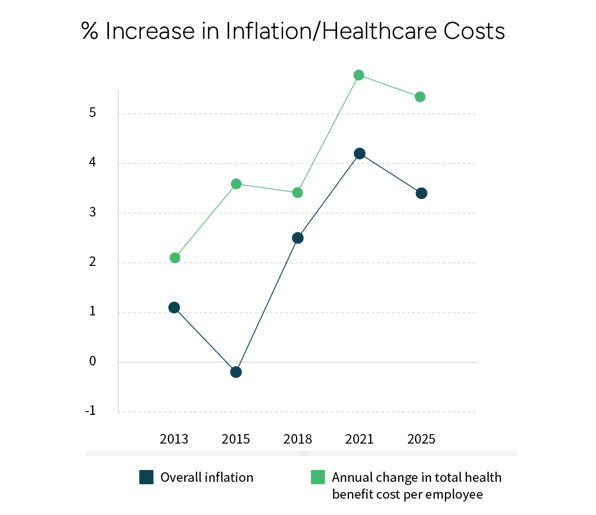At HTI, we stay innovative by keeping a sharp focus on what lies ahead. Through labor market analyses, consulting, and workforce surveys, we uncover predictive workforce insights that help employers better attract, manage, and retain top talent.
As we look toward 2025, here are four critical areas employers are prioritizing to navigate challenges and stay competitive: healthcare costs, cost-of-living adjustments, new benefits strategies, retention and other key focus areas shaping the year ahead. Let’s dive in.
Healthcare Costs
Workforce Outlook: Companies are bracing for a 5.8% increase in health benefit costs in 2025, even after accounting for planned cost-reduction strategies. This marks the third straight year with health benefit costs increasing above 5%, following a decade of modest 3% rises. Without these cost-reduction strategies, employers estimate that their costs would rise by about 7% on average (Mercer).

Factors: Rising employment levels and wage growth, driven by inflation, are pushing healthcare costs higher, according to Aon's North America chief actuary for health solutions, Debbie Ashford. She notes that the healthcare industry negotiates higher prices to meet these pressures, leading to elevated medical costs (SHRM).
Employer Response: In 2025, 53% of employers plan to make cost-cutting changes to their plans, an increase from 44% in 2024 (Mercer). Employers are implementing various strategies to manage rising expenses:
- Employee health affordability: Expanding high-performance networks, health savings accounts (HSAs), and lower-deductible plans to keep healthcare affordable.
- Behavioral health & caregiver support: Enhancing mental health resources such as Employee Assistance Programs (EAPs) and increasing childcare and eldercare benefits.
- Inclusive benefits & health equity: Addressing social determinants of health and expanding access to services like reproductive and gender-affirming care.
Cost of Living Adjustment (COLA)
Workforce Outlook: For 2025, the Cost of Living Adjustment (COLA) is 2.5%. This 2.5% COLA is the smallest in four years and slightly below the 20-year average of 2.6% (SSA).
Factors: Employers often use COLA as a benchmark for maintaining competitive salaries as well as budgeting and financial planning. That said, cooling inflation and labor market conditions indicate that we will see a slight reduction in planned salary increases in the coming year (Payscale).
Employer Response: In 2025, U.S. employers forecast 3.5% pay increases. To compare, pay increases in 2024 are 3.6% on average compared to 4% in 2023. However, raises can vary by up to 1.4% across different industries and sectors. Here’s why we might see some of those variations according to Payscale’s most recent salary budget survey:
- Organizations with higher compensation budgets cited competition for labor as the primary reason for higher budgets.
- Organizations with reduced salary budgets cited concerns about the economy as well as outsized compensation increases in years prior.
New Benefits Strategies
Compensation isn’t everything. What people value isn’t the same. To set yourself apart as an Employer of Choice, offer a variety of benefits. Not every benefit will hit home with every individual, but by having diverse offerings, your attraction and retention strategy benefits.
Workforce Outlook: In the benefits space, employee wellbeing remains a priority as healthcare costs are projected to rise, but companies are also exploring other strategies like pay transparency and customized benefits for different values.
Factors: Benefits have become a powerful way to stand out in today’s competitive labor market, playing a critical role in attracting and retaining top talent. Creative benefits like flexibility and mental health support—unheard of 20 years ago—are now shaping the standard for modern workplaces. It’s an evolving space, as companies focus on strengthening their culture and their appeal to employees.
Consider how each one of these focal points below could attract top talent, helping employers stand out amongst competition.
- Pay transparency: Pay transparency is gaining attention as a value point for employees. While not always considered a direct benefit, SHRM reports that 73% of U.S. workers are more likely to trust organizations that include pay ranges in job postings. Pay transparency can also enhance employee productivity and fulfillment, with 82% of workers reporting they are more productive and fulfilled by their work when they perceive their pay to be fair (GOCO).
- Customized benefits for different values: To attract and retain top talent, companies are getting more creative with their benefit offerings, focusing on customized benefits such as: personalization, flexibility, recognition platforms, wellness incentives, development opportunities, volunteer time off (VTO), and peer bonus programs.
Employer Response: In 2025, employee wellbeing is likely to remain the central focus when it comes to benefits, as well as creative and customized strategies that go beyond the traditional approach.
Top Priorities for Companies in 2025
Retention
Per a recent HTI survey, retention is the #1 top priority for companies in 2025.

Workforce Outlook: As companies aim to find the balance between remaining competitive in the market with rising healthcare costs and a close eye on inflation, it’s understandable that retention efforts are at the forefront of many employers’ minds.
Factors: Retention comes with a range of underlying challenges. Right now, three key challenges include a tight labor market, generational shifts, and the skills gap.
- Tight labor market: Workforce participation still lags pre-pandemic levels, with 1.7 million fewer Americans working compared to early 2020. There are currently 8 million job openings, but only 6.8 million unemployed workers (U.S. Chamber of Commerce).
- Generational Shifts: Emerging generations in the workforce bring new expectations and, with them, some friction. While 67% of Gen Z seeks skill-building opportunities for career growth, 55% plan to stay in a job for less than two years (Purdue Global). Finding common ground is essential for companies and employees. How can companies invest in employees’ growth and development while balancing the likelihood of shorter tenures?
- Skills Gap: Particularly challenging in manufacturing and tech-heavy industries, the skills gap is projected to leave 2.1 million U.S. manufacturing jobs unfilled by 2030. Employers face shortages across roles, from entry-level production associate positions as well as middle-skill jobs (Deloitte).
Employer Response: In 2025, projections for how companies are going to handle retention efforts are vast. Forbes mentioned authentic leadership, fair compensation, positive company culture, and growth opportunities—these continue to be major drivers of retention. But companies should not forget to focus on the small steps that are easy to execute (no brainers!) such as consistent, genuine check-ins, intentional unexpected gestures such as mailing a thank you note and a cool pair of socks to your team just to let them know how much you appreciate them. It sounds minimal—but small intentional actions can have the biggest impacts.
Ready to build a team that stays in 2025?
As we look ahead at 2025, now is the perfect time to partner with HTI, an unbiased advisor, helping companies zero in on attracting, managing, and retaining talent.
Start by knowing where you stand with your employees. Are they looking for opportunities elsewhere? What would make them stay? Answering these questions and building a robust retention strategy is essential to becoming an employer of choice—now, in 2025, and beyond. Reach out to learn more.
Training & Development
In our HTI survey, training and development was rated the second highest priority for companies. A valuable runner up!
Workforce Outlook: Employees continually cite career advancement and professional development as a top motivational driver in the workplace. We don’t foresee that changing in 2025, especially since development is a strong ingredient for employee retention.
Factors: Training and development remains a top priority for employers, driven by advancements in AI, employees actively seeking development, and a shift in hiring practices that emphasize skills over degrees.
- Advancements in AI: AI is transforming at a rapid pace across industries and 4 in 5 employees are eager to learn how to incorporate it into their roles (LinkedIn). Companies that prioritize AI training will not only boost employee confidence but also unlock new opportunities for growth and efficiency.
- Employees actively seek development: 94% of employees say they’d stay longer with an organization that invests in their training (TeamStage). As emerging generations join the workforce and the future of work evolves, it’s more important than ever for employers to support employee growth and development.
- Skills vs. degrees: Less focus on degrees and more focus on skills-based hiring—this will likely continue to be a trend. Earlier this year, the number of job ads requiring at least a college degree fell to 17.8%. Additionally, formal education requirements have declined in 87% of the occupational sector (SHRM).
Employer Response: In 2025, companies will likely prioritize tailoring development opportunities—AI and beyond—to align with employee interests, while balancing essential upskilling to drive organizational growth. With 90% of organizations citing retention as a key concern, offering meaningful learning opportunities will remain a critical driver for retaining top talent (LinkedIn).
Ready to expand development initiatives for 2025?
In the same way a company wants to expand and grow, so do its employees. To be an employer of choice, a place where people want to show up day in and day out—give employees the chance to challenge themselves in new, different ways.
Look for resources and trainings to expand pathways for development. At HTI, we offer up-to-date, unique trainings for employers and their people. Take a peek at our HTI Training Program Catalog.
That’s a wrap on your 2025 outlook! But listen, we understand that focusing on every single detail to stand out as a company in 2025 isn’t the objective. Find your biggest opportunities for growth—and drive them home. Don’t forget, you don’t have to do it alone, you can move the needle with us!



Comments